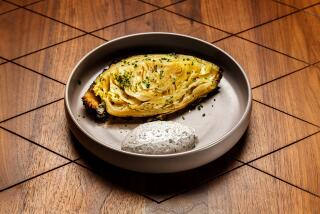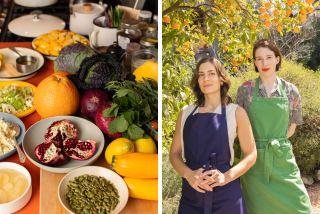A brilliant comeback
THE ups and downs of cauliflower’s fortunes have, in the 500-odd years since it was introduced to Europe, been extreme -- even by mercurial food-fashion standards. Probably originating in the Far East and carried by Arab traders to the Mediterranean, it was then brought to England by Flemish weavers in the mid-1600s and later became the rage of the French court, where Louis XV’s mistress Comtesse du Barry had a consomme of veal, oxtails and cauliflower named for her. In the modern era, however, cauliflower fell into a period of obscurity, languishing upon crudite trays and within over-baked gratins.
Perhaps the nadir came at a 1990 news conference, when then-President George H.W. Bush, discussing vegetables he didn’t have to eat anymore now that he was president, gave it a thumbs down along with broccoli, Brussels sprouts and lima beans.
But cauliflower has been having a renaissance lately, thanks not only to appealing colored varieties showing up in farmers markets and grocery stores but also to chefs who have rediscovered the vegetable’s subtle charms.
Cauliflower is being spotlighted for its nuanced flavors and rich nutty notes in such dishes as cauliflower panna cotta with beluga caviar at the French Laundry; sea urchin with lobster gelee and cauliflower cream at New York’s L’Atelier de Joel Robuchon; and, from the Fat Duck in Bray, Berkshire, in England, Heston Blumenthal’s cauliflower risotto with carpaccio of cauliflower and chocolate jelly.
A far cry from crudites.
Colored varieties such as purple Graffiti, orange Cheddar and stunning green Romanesco cauliflowers that are adorning market stalls and produce aisles now in a range of sizes are not genetically engineered but rather a mixture of heirloom varieties, naturally occurring accidents and the hybrids grown from them.
Purple and orange cauliflowers are fairly recent discoveries, dating back only a few decades to separate occasions when farmers noticed an unusually colored plant growing in a white-and-green cauliflower field. Scientists then bred the colorful anomalies into distinct varieties, improving upon taste, color and hardiness.
But the Romanesco cauliflower is an heirloom and isn’t to be confused with green cauliflower, or broccoflower, which is a cross between a broccoli and a cauliflower. Romanesco is astonishing in appearance, as much for its composition as for its color. Lime-green in hue, a head (or curd) of Romanesco is a near-perfect example of naturally occurring fractal: a fragmented geometric shape composed of smaller parts that are copies of the whole. The cauliflower resembles an M.C. Escher print more than something you’d find naturally occurring in your vegetable garden.
“The guys at Caltech come down and study them,” says Alex Weiser of Weiser Family Farms, in whose farmers market stands you’ll find all three varieties of cauliflower. “Something about the Mandelbrot theory.” But you don’t need a degree in mathematics to cook them. Whether they’re fully grown or beautiful babies, Weiser prefers his cauliflower roasted, with just a little sea salt and olive oil splashed on before they’re put in a hot oven.
The new cauliflower colors not only liven up the plate visually but also are significant indicators of flavor and health benefits.
Purple cauliflower, which gets its distinctive deep lavender color from anthocyanins, the antioxidant also found in red wine, has a milder flavor than white cauliflower -- it’s sweeter, nuttier and without the bitterness sometimes found in white cauliflower. Steamed, simmered or roasted, it retains its lavender beauty, especially with a little lemon or vinegar splashed on before cooking (though some purple varieties can turn green if overcooked).
Orange cauliflower varieties such as Cheddar are similarly mild and somewhat sweet, with a good dose of beta carotene. Romanesco, meanwhile, has a brighter, more floral flavor than traditional white. And even fully grown, all three varieties of cauliflower require shorter cooking times than the white cauliflower.
*
Chameleon characteristics
WHETHER it comes in brilliant green, earthy pale orange, shades of violet or traditional matte white, cauliflower is delicious lightly steamed or roasted, and it’s a wonderfully adaptive vegetable. A favorite in Indian koftas (croquettes) and curries, the cool creaminess of the cauliflower is the perfect foil for those dishes’ layers of spice and heat.
But cauliflower can also stand on its own, especially when its flavors are gently milked into a subtle cream or an ethereal panna cotta. Dairy provides a wonderful and gentle medium for cauliflower, bringing out its mellow yet distinctive essence.
In addition, the vegetable’s silky notes play off caviar particularly well. It also provides a terrific backdrop to other rich ingredients, such as sea urchin, lobster and truffles.
If black truffles aren’t your (or your accountant’s) cup of tea, try finishing a simple cauliflower soup with walnut oil. Gently simmer purple cauliflower and purple potatoes in milk with a few leeks that have been sauteed in butter, then simply puree and serve drizzled with a little oil. The oil’s richness plays off the smooth, subtle flavors of the soup, the walnut accentuating the inherent nuttiness of the cauliflower.
Or roast a whole chicken with a few heads of baby orange cauliflower, some tiny orange, purple and white carrots and a handful of toasted hazelnuts. The earthy notes of the chicken, the caramelized carrots and the crunchy hazelnuts bring out the subtle flavor of the cauliflower. And the dish looks remarkable, like a rustic, burnished feast.
Show off the glorious Romanesco cauliflower in a warm salad with Brussels sprouts pulled together by a luscious compound butter of mustard, lemon, marjoram and capers. Separated into individual florets and cooked gently, the fractals of the Romanesco become brilliant green, their geometric shapes strewn in the landscape of the salad like geodes.
When selecting cauliflower, look for heads without any speckles, and leaves that are strong and not wilted. White cauliflower is widely available year-round and thanks to their popularity with chefs, the purple, orange and Romanesco varieties are becoming increasingly easy to find. The colored varieties are seasonal and best from January through March. Most Whole Foods and Bristol Farms stores carry colored cauliflower in season. Farmers market availability varies according to weather; Weiser stands at the Santa Monica, Pasadena, Hollywood, Claremont, Beverly Hills and Venice farmers markets usually carry all three colors this time of year.
With so many colorful variations, cauliflower is one vegetable that shouldn’t have to worry ever again about the vicissitudes of style.
*
**
Cauliflower and Brussels sprouts salad with mustard-caper butter
Total time: 30 minutes
Servings: 8
Note: From “Local Flavors” by Deborah Madison. Romanesco cauliflower is available at Bristol Farms and Whole Foods markets, select supermarkets and farmers markets. White cauliflower can be substituted.
2 garlic cloves
Sea salt
6 tablespoons butter, softened
2 teaspoons Dijon mustard
1/4 cup drained small capers, rinsed
Grated zest of 1 lemon
3 tablespoons chopped marjoram
Black pepper
1 pound Brussels sprouts
1 small head ( 1/2 pound) white cauliflower
1 small head ( 1/2 pound) Romanesco (green) cauliflower
1. To make the mustard-caper butter, pound the garlic with a half-teaspoon salt in a mortar until smooth. Stir the garlic into the butter with the mustard, capers, lemon zest and marjoram. Season to taste with pepper. (The butter can be made a day ahead and refrigerated. Bring to room temperature before serving.)
2. Trim the base off the Brussels sprouts, then slice them in half or, if large, into quarters. Cut the cauliflower into bite-sized pieces.
3. Bring a large pot of water to a boil and add salt. Add the Brussels sprouts and cook for 3 minutes. Then add the other vegetables and continue to cook until tender, about 5 minutes. Drain, shake off any excess water, then toss with the mustard-caper butter. Taste for salt, season with pepper and toss again.
Each serving: 108 calories; 2 grams protein; 6 grams carbohydrates; 2 grams fiber; 9 grams fat; 5 grams saturated fat; 23 mg. cholesterol; 281 mg. sodium.
**
Roast whole chicken with cauliflower
Total time: 2 hours, 15 minutes
Servings: 6
Note: From “The Bistros, Brasseries and Wine Bars of Paris” by Daniel Young. (This recipe is from Thierry Breton of Chez Michel.) Orange cauliflower is available at Whole Foods and Bristol Farms stores, select supermarkets and farmers markets. White cauliflower can be substituted. Baby carrots of various colors are available at farmers markets.
1/2 cup hazelnuts
1 roasting chicken, 5 to 6 pounds
5 tablespoons butter, softened
Kosher salt
Freshly ground black pepper
1 pound mixed white and orange cauliflower
1 small head garlic
5 shallots, peeled and quartered
1 pound baby carrots, mixed colors, scrubbed under running water
Flat-leaf parsley, chopped, optional
1. Heat the oven to 350 degrees. Put the nuts on a baking sheet and toast them in the oven until browned and fragrant, about 10 minutes. Let cool, then coarsely chop the nuts. Set aside.
2. Raise the oven temperature to 425 degrees. Clean the chicken inside and out with cold water; pat dry with paper towels. Let stand for 20 minutes.
3. Smear the butter under the skin and on the outside of the chicken and season with 2 teaspoons salt and one-eighth teaspoon pepper. Tie legs together with kitchen twine. Place the chicken, breast side up, in a roasting pan, and cook until the skin begins to crisp, about 20 minutes.
4. While the chicken is roasting, prepare the vegetables. Wash the cauliflower and separate it into large florets. Separate the garlic cloves from the head and crush them by laying each clove on a flat surface and pressing down on it with the broad side of a large kitchen knife. Remove the peel. After the 20 minutes, distribute the crushed garlic cloves and shallots around the chicken in the pan, top with the cauliflower and carrots, and drizzle with 1 cup cold water. Season vegetables with salt and pepper to taste.
5. Lower the oven temperature to 350 degrees and cook, basting the bird and vegetables with the cooking juices two to three times, for 20 minutes more. Then scatter the hazelnuts over the cauliflower, basting every 10 minutes or so, until the juices run clear when you cut between a leg and a thigh, about 1 hour more.
6. Transfer the chicken to a warm serving platter and let stand 10 minutes. Surround the chicken with vegetables, spoon the cooking juices all over, garnish with parsley if desired, and serve immediately, carving at the table.
Each serving: 683 calories; 58 grams protein; 13 grams carbohydrates; 4 grams fiber; 43 grams fat; 14 grams saturated fat; 243 mg. cholesterol; 1,013 mg. sodium.
**
Purple cauliflower soup with walnut oil
Total time: 35 minutes
Servings: 4 to 6
Note: Purple cauliflower and potatoes are available at farmers markets and select Bristol Farms and Whole Foods. White cauliflower and potatoes can be used.
1 tablespoon butter
1 leek, white part only, thinly sliced ( 1/2 cup)
3 medium purple potatoes, peeled and quartered (about 1 1/2 cups)
Florets from 2 small heads purple cauliflower (3 1/2 cups)
4 cups whole milk
1/2 teaspoon kosher salt
1/8 teaspoon white pepper
Walnut oil for garnish
1. In a medium saucepan, melt butter over medium-low heat, add leeks and cook until soft, about 5 minutes. Add cauliflower, milk and salt and bring to a simmer. Cover and simmer on low heat until vegetables are soft, about 25 minutes. Do not boil.
2. Remove the vegetables from the heat, let cool slightly and puree them in a blender, with an immersion blender or in a food mill. (If using an immersion blender, cover with a towel to avoid splattering.)
3. If serving warm, reheat gently and serve with a drizzle of walnut oil. If serving cold, chill in the refrigerator before serving (also with walnut oil).
Each of 6 servings: 170 calories; 7 grams protein; 19 grams carbohydrates; 3 grams fiber; 8 grams fat; 4 grams saturated fat; 21 mg. cholesterol; 173 mg. sodium.
More to Read
Eat your way across L.A.
Get our weekly Tasting Notes newsletter for reviews, news and more.
You may occasionally receive promotional content from the Los Angeles Times.











